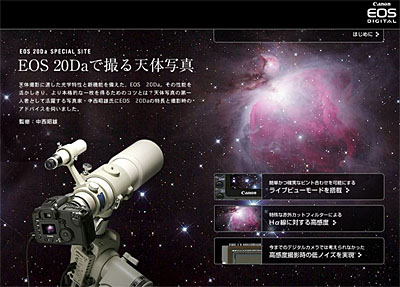
 |
| Home • Reviews • Forums • News 2015 • 2013 • 2012 • 2009 • 2008 • 2007 • 2006 • 2005 • 2004 RSS Feeds • FOV Factor Table • Sensor Sizes | Definitions: A-D • E-H • I-L • M-P • Q-U • V-Z | Sitemap Articles • Archived Websites (Pre-DigitalDingus): D100 Lounge • E-10 Club | Contact |
Canon Japan Announces 20Da for Astrophotographers |
| February 14, 2005 (Updated February 15, 2005) |
Japan - February 14, 2005 - Canon has intrigued astrophotographers by announcing the Canon 20Da. The 20Da has Infra-Red Filter reduced, enabling celestial photographers to shoot without an R64 IR filter attached to their lenses. So far, only Canon Japan has announced this version. At this time, it is not known whether Canon USA will offer this version for US digital photographers. Demand for the 20Da will certainly determine whether it will be offered in other countries, other than Japan. Some of you might be inquiring why a 20Da would be necessary. Let's take a brief look into why. You have two different types of celestial objects: Stellar and Nubular. Stellar objects emit light over a very wide spectrum, and a normal camera with reasonable low noise, can capture it quite well. Nebular objects can be photographed by a normal camera too, but, there are certain wavelengths that can only be captured. For Nebulae, these wavelengths are seen at 486.1nM, 495.9nM, 500nM, and 656.3nM. What The Wavelengths Mean The 486nM wavelength is basically a "neon blue" color. The 496-500nM are a blue-green color (maybe even referred to as aquamarine in color, but more on the "blue" side). Now, the 656nM wavelength is deep-red, and this is where normal cameras cannot capture properly, unless a special filter is attached to the lens, to allow more of this wavelength to enter. The reason why normal cameras don't capture the 656nM wavelength, is because if they did, colors would be off when processing. If you took a photo of a black car, it would actually show up as dark red when opened on your computer with a photo editor, or processed in your film lab. As you can see, there needs to be an IR filter on cameras which prevents this problem from occuring. Now, most people don't photograph celestial images, and if they do, it's only on occasion. However, if you're an astrophotographer, and your primary interest is in celestial objects, then using a "normal" camera can become irritating, because you have to purchase additional filters for any lens you may want to use. In addition to using filters, you lose image quality. High-qulaity filters are not cheap, and even then, you still lose the quality of your original lens in the first place (assuming you're using a very large aperture lens for this kind of photography--obviously, a f/5.6 lens is just not going to perform that well). Enter the Canon 20Da. Now, since the IR filter is not as aggressive (allowing 2.5x more IR light on the imager), you don't have to use filters anymore, and you can use your expensive lenses without any hinderance. What We Know So Far
For those who are thinking of purchasing a 20Da over the 20D just because it has better noise processing, please understand you will be very disappointed with normal daylight shooting. Since Canon has modified the IR filter to allow 2.5x more IR light into the imager, blacks will become dark red. In other words, if you were to photograph anything black, in the daytime, it would appear as dark red, and you would have to adjust the color levels in your photo editor accordingly (quite tedious at best).
Notes
Canon readily says that using the "Live View Mode" will not only diminish battery consumption quite quickly, but also will raise the temperature of the CMOS sensor as well. Canon recommends to use the "Live View Mode" as quick as possible. |
| Home • Reviews • Forums • News 2015 • 2013 • 2012 • 2009 • 2008 • 2007 • 2006 • 2005 • 2004 RSS Feeds • FOV Factor Table • Sensor Sizes | Definitions: A-D • E-H • I-L • M-P • Q-U • V-Z | Sitemap Articles • Archived Websites (Pre-DigitalDingus): D100 Lounge • E-10 Club | Contact |